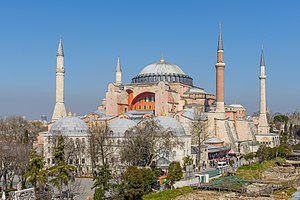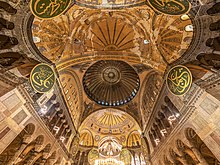Hagia Sophia
Hagia Sophia (Hi-lia̍p-gí: Ἁγία Σοφία, ì-sù: "Sîn-sèng Tì-hūi"), chá-chêng sī Tang-chèng-kàu ê kàu-tn̂g; āu-lâi sī I-su-lân-kàu ê chheng-chin-sī; hiān-sî sī phok-bu̍t-koán. Só͘-chāi tī kin-á-ji̍t ê Istanbul.
 Hagia Sophia was built in 537, with minarets added in the 15th–16th centuries when it became a mosque.[1] | |
 | |
| Location | Turkey Istanbul Fatih |
|---|---|
| Designer | Isidore of Miletus Anthemius of Tralles |
| Type | |
| Material | Ashlar, Roman brick |
| Length | 82 m (269 ft) |
| Width | 73 m (240 ft) |
| Height | 55 m (180 ft) |
| Beginning date | 360 nî |
| Completion date | 537 nî |
| Dedicated to | The Holy Wisdom, a reference to the second person of the Trinity, or Jesus Christ[2] |
| Website | |
| Part of | Historic Areas of Istanbul |
| Criteria | Cultural: i, ii, iii, iv |
| Reference | 356 |
| Inscription | 1985 (Tē-9 session) |


Tsù-kái
Tsù-kái
- Istanbul
🔥 Top keywords: Thâu-ia̍hCarles PuigdemontMarie AntoinetteWikipediaWikipedia:Siā-lí mn̂g-chhùi-kháuPang-chān:Bo̍k-lio̍kTek-pia̍t:尋討Tē-jī-chhù Sè-kài Tāi-chiànPortal:Sin-bûn sū-kiāⁿWikipedia:Hoan-gêng sin iōng-chiáLūi-pia̍t:Choân-pō͘ phí-á-kiáⁿ bûn-chiuⁿWordPressWikipedia:Chhiū-á-khaWikipedia:Bián-chek seng-bêngWikipedia:Chiūⁿ-bāngEdgeworth (Pennsylvania)Wikipedia:It-poaⁿ ê seng-bêngKitagawa KeikoLating jī-bióWikipedia:Tāi-sài-koánIōng-chiá thó-lūn:Ndgf741Sin-bûn sū-kiāⁿDigital Monster6Eng-gíTek-pia̍t:最近其改變Bân-lâm-gúQR BéTek-pia̍t:我其貢獻Tōa hun-koah ko chè-liōng tiâu-kiông hòng-siā tī-liâuÌn-tō͘Bí-kokSò͘-ūi Mi̍h-kiāⁿ Sek-pia̍t-hōPang-bô͘:Cite webSHA-2TomorAzumanga DaiohISO 8601tóng-àn:Nalvadi Krishnaraja Wodeyar 1881-1940.jpg